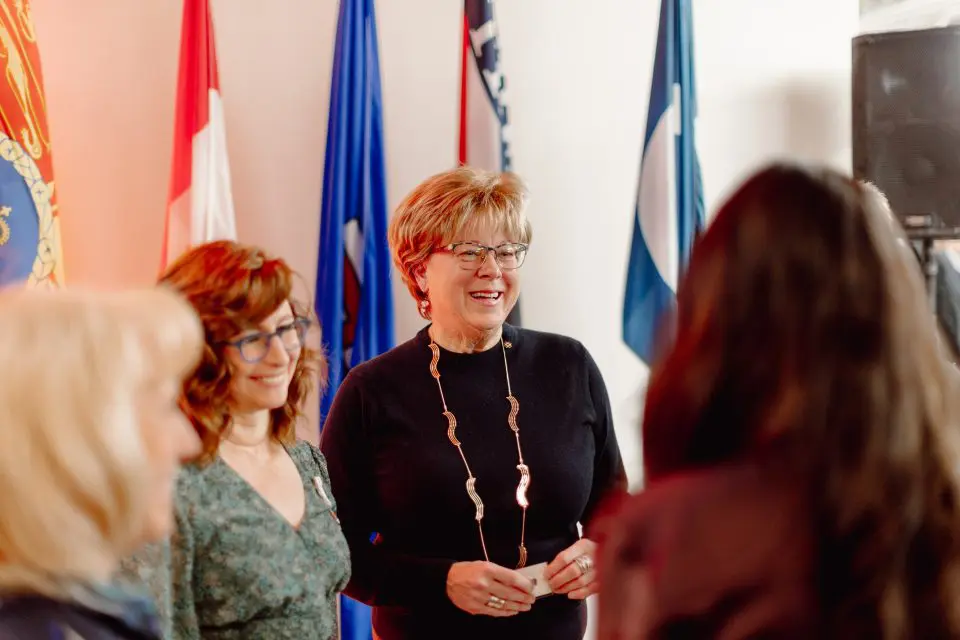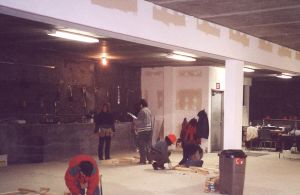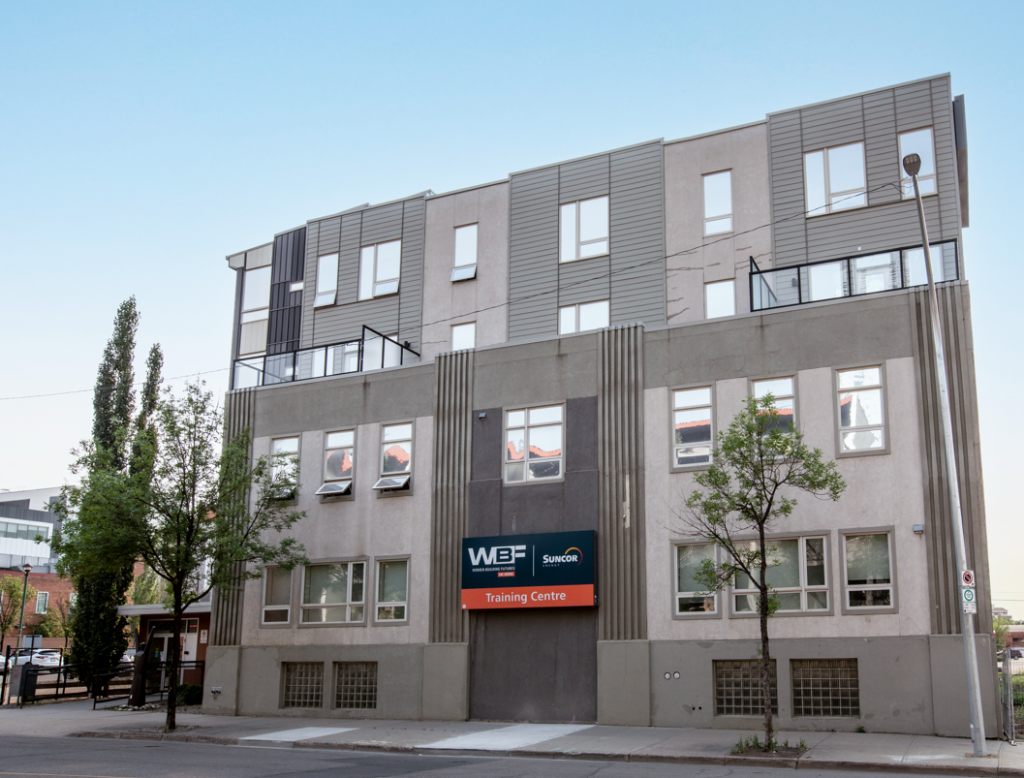“The timing felt right”

- Published On
- September 11, 2023
JudyLynn Archer, founding president and CEO, reflects on the early years and growth of Women Building Futures.
JudyLynn Archer joined Women Building Futures in 2002 determined to grow the fledging non-profit into a sustainable organization that would continue to provide women with the tools to change their lives for decades to come.
She spoke with Women Building Futures about those formational years.
Here are edited excerpts.
On meeting the founders of Women Building Futures:
At the time I met them it was serendipitous. I met one of them, Jenny Kain, because I was working on a project for someone in Vancouver who was doing a study on women in poverty in Canada. They asked me to help them out doing some research here in Edmonton. And so, I asked around – who in Edmonton would be a great person to contact about this topic? – and Jenny Kain’s name came up. I heard how Jenny, Marcia Tait, Monika Wichman and others had established a non-profit organization called Women Building Futures.
They had had a few small grants. They had hired a person to deliver some basic safety training and carpentry training. They didn’t have a location or anything like that.
On joining WBF:
I really liked their concept. I could relate to it from my own life experience, especially single mothers living in poverty with their kids, and what a big fat drag it is. So I was quite taken with that.
On the other hand, I couldn’t see that they had a plan on how they were going to get industry on side. And if we couldn’t get industry on side, at some point, it would never work. I was kind of excited, but I had a lot of doubts at the time.
However, in my own life at the time, I didn’t like the work I was doing. So I quit that job and just said I will try to see what we could do. I had no experience trying to get an organization together. I did a lot of research. I read all the documentation. I started talking to people. I started talking to industry.
On the need and the opportunity:
There was no shortage of supply – there are lots of women in poverty. And at the same time, industry was beginning to say, oh my gosh, you know, we’re going to be running out of skilled tradespeople. We just needed to find a way to connect those dots.
On WBF’s first dedicated training location:

One day, I was talking to somebody, and they said, “We have a basement that’s empty. It’s underneath a Mailboxes, Etc. store on Jasper Avenue. If you want to lease it, you could lease it for 3 years.”
We didn’t have enough money to really sign a lease. But we signed it.
It was just an empty basement. It was 4,000 square feet of empty concrete [pictured left] with a light bulb. But the social workers started sending over women and one of them was working as a carpenter, and she and several other women helped us lay out a plan for how we could build a little training centre down there.
We wanted to have a tool crib, workbenches, a couple of bathrooms and an office area.
I went around and begged and borrowed and found construction material. And really, by the time that we moved out 3 years later, we had a really lovely little training centre down there.
On buying the warehouse in downtown Edmonton that is home to the main office, training centre and affordable housing:
We bought the warehouse [in 2005]. This was all a bit risky. There were no firm funding agreements. We were really going on hope, intuition, passion. And also, the timing felt right.
It wasn’t the ideal building, that’s for sure. But I felt it was in a really good location because it was right on the bus route. It was close to some childcare at Norquest and the Y.
A businessman from the community stepped forward and loaned us the money with a very friendly financial repayment plan. 
But it was a very difficult time for Women Building Futures, when you’re trying to raise a lot of money quickly, from nothing, really.
Even physically, we couldn’t stay in that building. While Clark Builders was demolishing the inside, we had to move out. We set up trailers in the parking lot out back. We were out there for a year and a half, I believe, running classes in a trailer.
We did the best that we could.
[In 2008, Clark Builders completed the construction of the WBF Training Centre, Canada’s first trades training facility for women, pictured above.]
On adding affordable housing in the building:
The lack of affordable housing makes it almost impossible for many women to commit to a training program. And so, we built 42 units of affordable housing at the same time we built the workshops.
On building partnerships with companies to hire WBF grads:
It was very difficult to get companies to hire women for a long, long time. It took probably 10 years before it felt like, okay, we’re starting to make headway.
I really felt that they would come if we just kept pressing on and securing the kind of industry partnerships, like SureHire and the Alberta Construction Safety Association, so we could produce graduates that would meet or exceed industry standards, not just for safety, but for work ethic and preparedness, and grads who really understood and wanted to learn a trade.
And companies came forward and said we want to work with you. We believe in what you’re doing. We want to see these women be successful. And here’s how we think that we can help, and it was awesome.
On seeing the impact of WBF’s work:
If you’ve ever been raised in poverty, you know that cycle and it’s impossible to get out and it affects every aspect of your life. This is how it was for me in my life. We didn’t know where we were going to be at any given time. You don’t know where you’re going to be sleeping or what’s going to be happening. You’re just in survival mode all the time.
I remember a number of individuals who had the work ethic that it would require. They had a toughness of spirit that it would require, but they had a lot of challenges. And then to see them coming back as a journeyman, talking to a class about where they were now.
There’s one I didn’t recognize when she came to speak in the classroom. Her body language was just completely different. She was like a completely different person. And that’s because she was a journeyman. She was working on her next ticket. She was part of the training team at a fabulous company. Her life completely changed. She had her own home.
When we heard those stories, those are the times where we felt, okay, now we can go back to our desk and keep shuffling all this paper and applying for all these grants, because it’s all worthwhile.
It was those little moments of seeing what they were doing with their lives and knowing that we had a little tiny part to play in it. It was awesome.
On her time with WBF:
The opportunity to get involved with women building futures was life changing for me, personally. It was a real honour and opportunity.
I often wish my mom could have seen that something like Women Building Futures came along to help women like her.
On everyone who contributed to WBF’s success:
Women Building Futures took many people working arm in arm toward the shared dream for years and years to get it to where it is today – an incredible board of directors and internal team, external government and industry partners; it was an extraordinary effort on everyone’s part.
JudyLynn Archer was president and CEO of Women Building Futures from 2002 to 2015.
